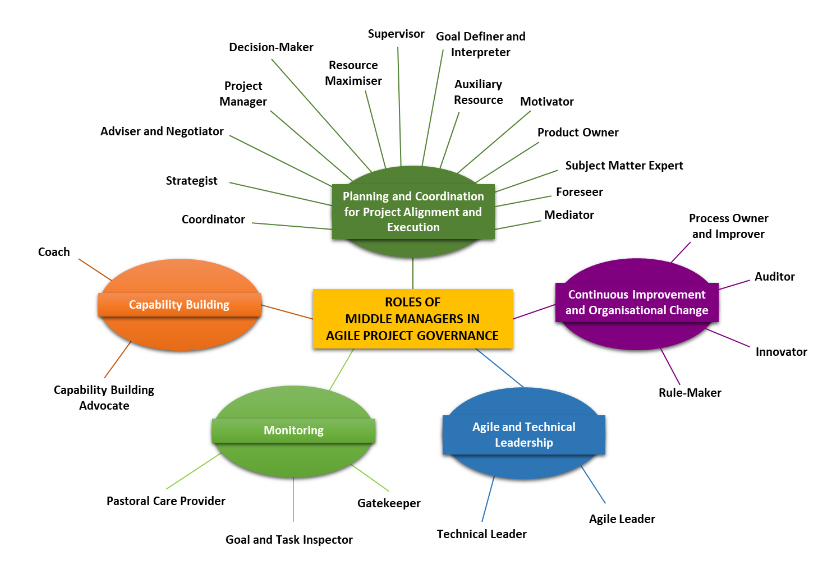Agile practitioners and scholars have engaged in much research to understand agile software teams and how they operate to support value-driven delivery of projects, services and business operations in agile organisations.
However, an important part of the governance structure of agile software projects which has received very little research focus is middle management. Project governance is an important but complex activity performed during agile software projects, and includes the necessary oversight, decision-making, processes, tools, support, and manpower to accomplish projects and maintain strategic alignment.
Middle managers constitute this support and manpower. Middle managers are the intermediary workforce that link senior management with other teams and personnel that operate in an organisation. However, there is a lack of clarity about their role, as well as a lack of research-based evidence regarding the value and contributions they bring to agile teams, projects, and organisations.
The idea of middle managers working in agile teams and projects to support the adaptive and innovative culture of the agile business is ambivalent and contentious. While some practitioners and scholars oppose the idea of middle managers because they are deemed unnecessary and harmful to the agile way of working, others take a more enthusiastic stance with the belief that middle managers can contribute to organisational agility.
This blog presents findings from a Nigerian multiple-case study (Uwadi et al., 2022), which sheds light on middle managers in agile organisations. Two Nigerian financial services companies were involved in the study: a fintech holding company and a Microfinance bank. The study found 25 roles (Figure 1) that agile middle managers perform. It investigated project governance activities in two agile software development projects, to determine the roles of middle managers in agile project governance and the implications for agile teams and organisations in practice. The middle managers, through the identified 25 roles, supported each organisation’s agile team within the project governance activity of their respective agile software projects.

Figure 1: Model of 25 middle management roles in agile project governance
Our research presents practical examples of each of these roles. For example, in the Strategist role, middle managers in the two companies engaged in strategic practices to come up with ways to accomplish the goals and expectations of their agile projects. They were instrumental in helping to ensure project needs and challenges were handled by engaging in resource planning and devising specific project solutions, for example. Also, in the Innovator role, the middle managers fostered innovation and change to enhance project governance practice in their respective agile software projects, for greater efficiency and to achieve project expectations. They were involved in recommending and introducing new practices, ideas, and technological tools to help improve, support, and advance project delivery. Descriptions of the roles, which also provide a sense of the impact of agile middle managers on agile teams and projects, can be found in the research paper.
Ultimately, our research indicates that middle managers played pivotal roles in the agile teams and in project governance practice within the agile software projects in the examined companies. These findings should not only help clarify our understanding of the middle management role, but also help allay fears regarding redundancy for middle managers, which may result from the adoption of agile methods.
The reality of agile transformation is that it causes organisational changes, which impact middle managers and project governance: changes in structures and organisational roles, processes and procedures, management and leadership styles, for example. Therefore, our model of middle management roles in agile project governance may help senior management, middle managers, and agile teams, in general, to better understand the roles and responsibilities of middle managers. This should help promote agile project governance practices to create a stronger organisation – including project strategic connections and project success, as well as healthy working relationships between middle managers and their team members.
As organisations continue to use agile methods, it is important to ascertain, recognise, and encourage their adoption beyond western countries for the global growth of agile practice. Hence, our research draws attention to the fact that Nigerian organisations are using agile for their strategic initiatives, which agile middle managers can successfully orchestrate, facilitate, and support.
Hopefully, our findings will not only encourage more Nigerian organisations to embrace the agile philosophy, but also encourage African organisations in general to see the practicality of agile methods for their teams and projects so that they can become agile organisations and operate more effectively with business agility. Given that the two organisations in our study operate in the finance industry, it is worth noting that the industry is highly regulated. Also, Nigeria is a country where a hierarchical culture dominates the working environment. Hence, the way governance is carried out, and middle managers operate within agile projects in such contexts, may be influenced by industry and regional culture. That notwithstanding, agile practitioners, agile teams, and organisations in similar contexts may gain useful insights from our research findings.
Reference:
Uwadi, M., Gregory, P., Allison, I., & Sharp, H. (2022). Roles of Middle Managers in Agile Project Governance. In: Stray, V., Stol, KJ., Paasivaara, M., Kruchten, P. (eds) Agile Processes in Software Engineering and Extreme Programming. XP 2022. Lecture Notes in Business Information Processing, vol 445. Springer, Cham. https://doi.org/10.1007/978-3-031-08169-9_5.
Please note blogs reflect the opinions of their authors and do not necessarily reflect the recommendations or guidance of the Agile Business Consortium.



